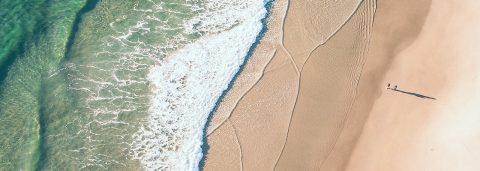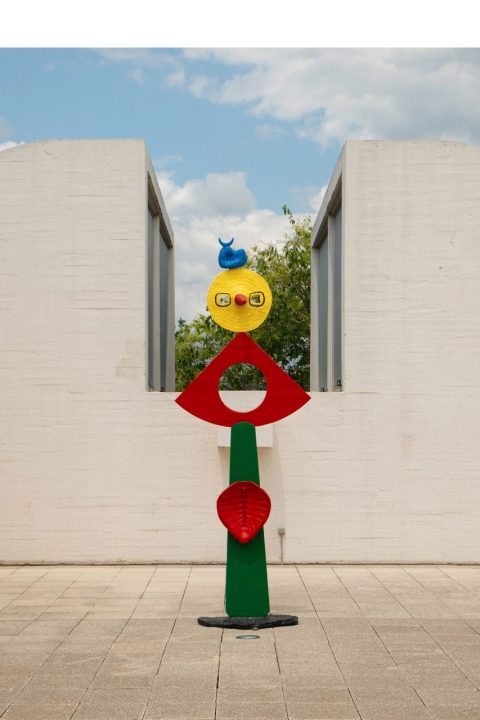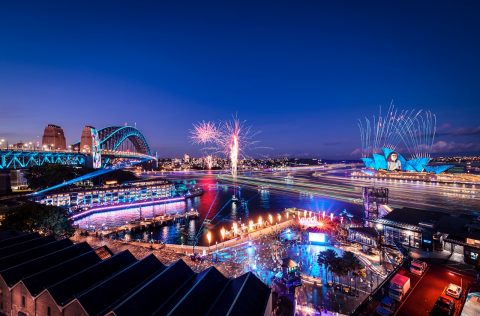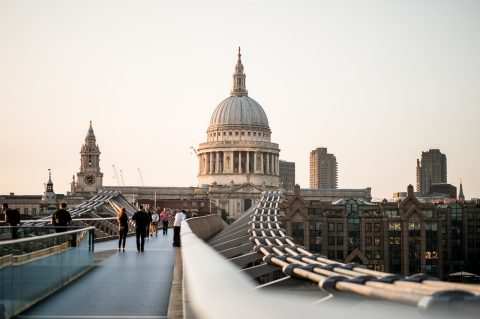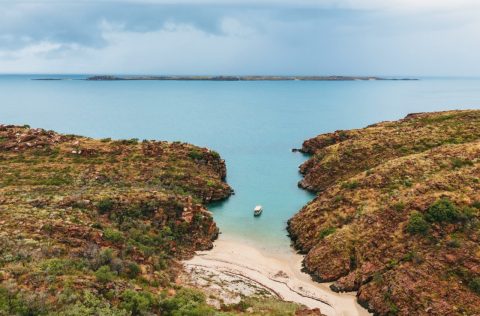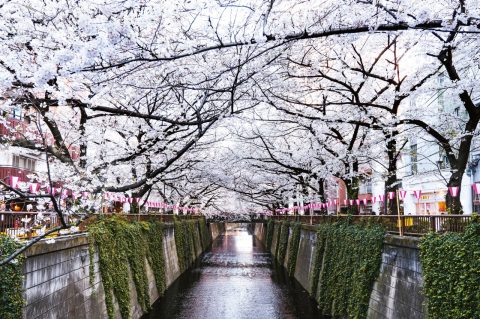The Most Beautiful Blue Places in the World
Beyond sea and sky, blue’s occurrence in nature is rare. And whether it’s the scarcity effect or the hue’s calming qualities, there’s no denying that it’s long been a subject of fascination. Besides cultural cachet (Joni Mitchell’s Blue album and Levi Strauss’s blue jeans), the colour’s true power may lie in its impact on bodies and minds. In the world’s Blue Zones – coastal parts of Greece, Japan and Italy among them – the locals are said to live longer than average, consistently making it to 100 years old. But you can’t change your address so change your mood: a recent study found that exposure to blue spaces – being in, on or near water – can enhance wellbeing and alleviate stress. Our advice? Immerse yourself in these spectacular destinations.
Image credit: ImageMagick
The Blue Lagoon, Grindavík, Iceland
1/9A small island located at the confluence of the North Atlantic and Arctic oceans, Iceland boasts more superlative natural beauty than countries far bigger, thanks to snowcapped volcanic peaks, lava fields, glittering ancient glaciers and a coastline engraved with fjords.
It’s odd, then, that Iceland’s most popular attraction, the Blue Lagoon, is the result of human endeavour. Stranger still that this series of warm milky-blue pools, obscured by wispy plumes of steam, are a happy accident: the water is settled condensation from nearby Svartsengi geothermal power plant that’s warmed by a lava field. In another fortunate happenstance, naturally occurring silica provides the glowing blue colour and purported skin-healing properties. Only in a Nordic country could the result of energy production be both stunningly beautiful and useful.
Go for a blissful day of soaking or book into The Retreat, where the lucky inhabitants of its 60 suites have access to a private lagoon pool, a subterranean spa for mineral-rich mud treatments and a Michelinstarred restaurant.
Blue Monochrome, MoMA, New York City, US
2/9In the 1950s, artist Yves Klein’s quest for a kind of chromatic purity and his obsession with purging colour of its external associations drove him to enlist the help of Parisian chemist Edouard Adam to create a blue of outstanding vividness. The resulting shade, International Klein Blue, was registered in 1960, cementing what would become his legacy. “Blue is the invisible becoming visible,” the artist once said.
Not just any blue but Klein’s own electric, radiant, crazed blue. It hungrily draws the eye as you enter gallery 406 on the fourth floor of New York City’s MoMA. There, Klein’s painting Blue Monochrome pulsates on a stark white wall. Linger a while and the power of the rectangle of colour, measuring just under two metres tall, will slowly reveal itself – it’s a blue you could almost drown in.
Image credit: Dominik Kuhn
Capela das Almas, Porto, Portugal
3/9It seems that Portugal wears its history on its sleeve, from the French influence on the national sandwich, the Francesinha, to the gift of wine-making left behind by the Romans. But perhaps most appealing is the Moorish tradition of covering any and all bare surfaces with decoration. Case in point: Capela das Almas (Chapel of Souls), an 18th-century church in the middle of Porto’s Rua de Santa Catarina shopping street that’s more enchanting than any shop window.
Its exterior is clad entirely in azulejos, the small, hand-painted ceramic tiles that adorn many of the city’s houses, churches and railway stations. The tiles became widespread after Portugal’s King Manuel I’s 1503 visit to Seville, then the centre of the azulejo industry. Capela das Almas didn’t receive its blue-and-white ensemble until 1929, with this small chapel’s azulejos depicting the death of Saint Francis of Assisi and the martyrdom of Saint Catherine of Alexandria. Each tile – all 15,947 of them – is a tiny work of art.
Image credit: Robert Harding
Capillas de Mármol, Aysén region, Chile
4/9Michelangelo spent four years creating the frescoes that adorn the ceiling of the Sistine Chapel in Vatican City; it’s taken 6200 years for Mother Nature to carve the undulating marble caverns and grottoes of Capillas de Mármol (Marble Cathedral) found in General Carrera Lake. Admirable, yes, but what takes it to the level of high art is the interaction of water and sun. The lake is fed by glacial meltwater in which particles of silt remain suspended, refracting sunlight to create an other-worldly blue. Reflected on the interior of the cloistered caves, the colour oscillates between duck-egg and deep cerulean, depending on the season, the time, the weather and your mood.
If entering this serene marble maze, which is accessible only by boat, feels like a spiritual awakening – the sense of communally held breath, the stillness – then it’s fitting that it takes something of a pilgrimage to get to it. First, you travel to the town of Balmaceda then drive just over three hours along the Carretera Austral (Southern Highway) to the small town of Puerto Río Tranquilo. There, you board a vessel to a place few are adventurous enough to visit.
Image credit: Nicolas Mathéus, courtesy of Fondation Jardin Majorelle
Jardin Majorelle, Marrakech, Morocco
5/9Within Morocco’s fabled Pink City is a spectacular cobalt compound within a lush blue-walled garden that was once owned by a legendary French couturier. Yves Saint Laurent first visited Marrakech in 1966 and in no time at all, the city became his muse. “Before Marrakech, everything was black,” he once said. “This city taught me colour.”
Enamoured of the sun-dappled locale, redolent of spice and echoing with the call to prayer, Saint Laurent and his partner, Pierre Bergé, bought Jardin Majorelle and the adjoining home, Villa Oasis, in 1980. They restored the luxuriant one-hectare garden – to which its former owner, artist Jacques Majorelle, had devoted almost 40 years – shaded with exotic species, musical with fountains and adorned with pots and pillars painted ultramarine. The vivid hue was inspired by Berber architecture and Majorelle sought to recreate it in its purest form; Bleu Majorelle has since become trademarked. The garden is open to the public daily (tickets must be purchased online) and private tours of the Villa Oasis are only available through select five-star hotels, including the Four Seasons Resort Marrakech.
Image credit: Katie Purling
Museum of Underwater Art, Townsville, Queensland
6/9The Great Barrier Reef comprises more than 2500 individual reefs, 900 islands, 400 types of coral and 1600 species of fish – a vast aquamarine dot painting that’s visible from space. This masterwork of evolution is also the site of a unique artistic undertaking: Jason deCaires Taylor has created a series of sculptures then positioned them on the ocean floor in a fusion of art, marine science and conservation. The Museum of Underwater Art showcases his sunken and semi submerged works at three locations on the Queensland coast. Ocean Siren, next to The Strand Jetty in Townsville, is both art and clarion call about the effect of warming oceans on the reef: its LED lights range from blue to red in response to the water temperature. Coral Greenhouse, 16 metres below at John Brewer Reef, dissipates undercurrents to give relief to recovering reefs. Nearby, Ocean Sentinels honours conservationists in the form of eight 2.2-metre-tall statues. Museum entry is free but you’ll need to book a dive tour to reach the depths.
Image credit: Prosha Amiri
Joffre Lakes Park, British Columbia, Canada
7/9You won’t find rock flour in the baking aisle – it’s the result of bedrock being ground down by glacial erosion into a super-fine silt. When suspended in water, in the case of Joffre Lakes Park, about three hours’ drive north of Vancouver, rock flour appears as a brilliant turquoise.
It’s possible to achieve almost instant gratification here but as with most things in life, the greater the effort, the sweeter the reward. There are three lakes at Joffre: Lower, Middle and Upper. Lower Joffre Lake is only 500 metres from the car park and offers suitably magnificent views of iridescent water and alpine scenery. At Middle Joffre you’ll find the “selfie log”, on which self-documenters risk life and limb to inch into the ecstatic blue. At Upper Joffre, Matier Glacier hangs above the azure expanse. All you need are sturdy hiking boots and a free day pass during the warmer months.
Image credit: Miguel Sobreira
Museo Frida Kahlo, Mexico City, Mexico
8/9In Coyoacán, a neighbourhood of Mexico City, a queue forms from Tuesday to Sunday outside the lapis lazuli-painted walls of the house in which renowned artist Frida Kahlo lived, worked and died.
Known as La Casa Azul (the Blue House), it opened as Museo Frida Kahlo in 1958, four years after the artist’s death at 47. Kahlo and her artist husband, Diego Rivera, painted their home in its unmissable hue in 1941, representing their admiration for the culture of Mexico’s Indigenous people.
Inside, artworks abound – colonial-era paintings, Mexican folk art and pieces by Paul Klee and José Maria Velasco. But objects that belonged to Kahlo herself are the most moving: her Tehuana-style clothing and jewellery; handpainted medical corsets; the mirror above her bed that she used to create her first self portraits. In the bright kitchen, a yellow dining table is set with six matching chairs, a tableau into which only a little imagination is required to insert Kahlo, Rivera and one of their frequent visitors, Leon Trotsky.
